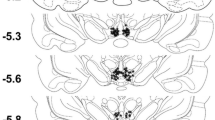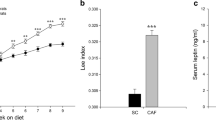Abstract
Leptin is an anorexigenic hormone that acts via its receptor (LepR) to regulate the hypothalamic arcuate nucleus circuitry to mediate energy homeostasis and feeding behavior. Moreover, leptin decreases the reward value of natural and artificial rewards, and low levels of circulating leptin have been implicated in several mood disorders linking leptin to the mesolimbic system. Therefore, the purpose of this study was to assess whether and to what extent an acute intranasal application of leptin is able to modulate monoamine neurotransmitters in the nucleus accumbens (NAc). Microdialysis experiments were carried out in freely moving Wistar rats and in LepR-deficient Zucker rats (LepRfa/fa). Samples were analysed for the levels of dopamine (DA), serotonin (5-HT), and their metabolites using high-performance liquid chromatography with electrochemical detection. We show that in Wistar rats, nasal application of leptin dose-dependently increased extracellular DA and 5-HT levels in the NAc. By contrast, in the LepRfa/fa rats, nasal application of 0.12 mg/kg leptin failed to increase levels of either DA or 5-HT, but their metabolites (DOPAC and HIAA, respectively) were significantly decreased. In addition, leptin interaction with the melanocortin system was tested. Nasal co-administration of leptin and the melanocortin receptor antagonist, SHU9119, completely abolished the leptin-induced increase of both DA and 5-HT outflow in the NAc. These results indicate a marked leptin effect on the basal ganglia-related reward system involving melanocortin receptors.



Similar content being viewed by others
References
Arnold JJ, Ahsan F, Meezan E, Pillion DJ (2004) Correlation of tetradecylmaltoside induced increases in nasal peptide drug delivery with morphological changes in nasal epithelial cells. J Pharm Sci 93(9):2205–2213. doi:10.1002/jps.20123
Atmaca M, Kuloglu M, Tezcan E, Ustundag B, Bayik Y (2002a) Serum leptin and cholesterol levels in patients with bipolar disorder. Neuropsychobiology 46(4):176–179. doi:10.1159/000067809
Atmaca M, Kuloglu M, Tezcan E, Ustundag B, Gecici O, Firidin B (2002b) Serum leptin and cholesterol values in suicide attempters. Neuropsychobiology 45(3):124–127
Calapi G, Corica F, Corsonello A, Sautebin L, Di Rosa M, Campo GM, Buemi M, Mauro VN, Caputi AP (1999) Leptin increases serotonin turnover by inhibition of brain nitric oxide synthesis. J Clin Investig 104(7):975–982. doi:10.1172/JCI5867
Clément K, Vaisse C, Lahlou N, Cabrol S, Pelloux V, Cassuto D, Gourmelen M et al (1998) A mutation in the human leptin receptor gene causes obesity and pituitary dysfunction. Nature 392(6674):398–401. doi:10.1038/32911
Di Leone RJ (2009) The influence of leptin on the dopamine system and implications for ingestive behavior. Int J Obes (2005). doi:10.1038/ijo.2009.68 (Nature Publishing Group: S25–29)
Di Matteo V, Di Giovanni G, Pierucci M, Esposito E (2008) Serotonin control of central dopaminergic function: focus on in vivo microdialysis studies. Prog Brain Res. doi:10.1016/S0079-6123(08)00902-3
Fan W, Boston BA, Kesterson RA, Hruby VJ, Cone RD (1997) Role of melanocortinergic neurons in feeding and the agouti obesity syndrome. Nature 385(6612):165–168. doi:10.1038/385165a0
Farooqi IS, Jebb SA, Langmack G, Lawrence E, Cheetham CH, Prentice AM, Hughes IA, McCamish MA, O’Rahilly S (1999) Effects of recombinant leptin therapy in a child with congenital leptin deficiency. N Engl J Med 341:879–884. doi:10.1056/NEJM199909163411204
Finn PD, Cunningham MJ, Rickard DG, Clifton DK, Steiner RA (2001) Serotonergic neurons are targets for leptin in the monkey. J Clin Endocrinol Metab 86(1):422–426. doi:10.1210/jc.86.1.422
Fliedner S, Schulz C, Lehnert H (2006) Brain uptake of intranasally applied radioiodinated leptin in wistar rats. Endocrinology 147(5):2088–2094. doi:10.1210/en.2005-1016
Friedman JM (2011) Leptin and the regulation of body weight. Keio J Med 60(1):1–9. doi:10.2302/kjm.60.1
Fulton S, Pissios P, Manchon RP, Stiles L, Frank L, Pothos EN, Maratos-Flier E, Flier JS (2006) Leptin regulation of the mesoaccumbens dopamine pathway. Neuron 51(6):811–822. doi:10.1016/j.neuron.2006.09.006
Halaas JL, Gajiwala KS, Maffei M, Cohen SL, Chait BT, Rabinowitz D, Lallone RL, Burley SK, Friedman JM (1995) Weight-reducing effects of the plasma protein encoded by the obese gene. Science 269(June):26–29. doi:10.1126/science.7624777
Hay-Schmidt A, Helboe L, Larsen PJ (2001) Leptin receptor immunoreactivity is present in ascending serotonergic and catecholaminergic neurons of the rat. Neuroendocrinology 73(4):215–226. doi:10.1159/000054638
Heisler LK, Cowley MA, Tecott LH, Fan W, Low MJ, Smart JL, Rubinstein M et al (2002) Activation of central melanocortin pathways by fenfluramine. Science 297(5581):609–611. doi:10.1126/science.1072327
Hommel JD, Trinko R, Sears RM, Georgescu D, Liu ZW, Gao XB, Thurmon JJ, Marinelli M, DiLeone RJ (2006) Leptin receptor signaling in midbrain dopamine neurons regulates feeding. Neuron 51(6):801–810. doi:10.1016/j.neuron.2006.08.023
Hsu R, Taylor JR, Newton SS, Alvaro JD, Haile C, Han G, Hruby VJ, Nestler EJ, Duman RS (2005) Blockade of melanocortin transmission inhibits cocaine reward. Eur J Neurosci 21(8):2233–2242. doi:10.1111/j.1460-9568.2005.04038.x
Hurd YL, Ungerstedt U (1989) In vivo neurochemical profile of dopamine uptake inhibitors and releasers in rat caudate-putamen. Eur J Pharmacol 166(2):251–260. doi:10.1016/0014-2999(89)90066-6
Kask A, Rägo L, Wikberg JES, Schiöth HB (1998) Evidence for involvement of the melanocortin MC4 receptor in the effects of leptin on food intake and body weight. Eur J Pharmacol 360(1):15–19. doi:10.1016/S0014-2999(98)00699-2
Kawashima N, Chaki S, Okuyama S (2003) Electrophysiological effects of melanocortin receptor ligands on neuronal activities of monoaminergic neurons in rats. Neurosci Lett 353(2):119–122. doi:10.1016/j.neulet.2003.09.024
Kenny PJ (2011) Common cellular and molecular mechanisms in obesity and drug addiction. Nat Rev Neurosci. doi:10.1038/nrn3105
Kraus T, Haack M, Schuld A, Hinze-Selch D, Pollmächer T (2001) Low leptin levels but normal body mass indices in patients with depression or schizophrenia. Neuroendocrinology 73(4):243–247
Kristensen P, Judge ME, Thim L, Ribel U, Christjansen KN, Wulff BS, Clausen JT et al (1998) Hypothalamic CART is a new anorectic peptide regulated by leptin. Nature 393(6680):72–76. doi:10.1038/29993
Krügel U, Schraft T, Kittner H, Kiess W, Illes P (2003) Basal and feeding-evoked dopamine release in the rat nucleus accumbens is depressed by leptin. Eur J Pharmacol 482(1–3):185–187. doi:10.1016/j.ejphar.2003.09.047
Leinninger GM, Jo YH, Leshan RL, Louis GW (2009) Leptin acts via leptin receptor-expressing lateral hypothalamic neurons to modulate the mesolimbic dopamine system and suppress feeding. Cell Metab. doi:10.1016/j.cmet.2009.06.011
Leshan RL, Opland DM, Louis GW, Leinninger GM, Patterson CM, Rhodes CJ, Münzberg H, Myers MG (2010) Ventral tegmental area leptin receptor neurons specifically project to and regulate cocaine- and amphetamine-regulated transcript neurons of the extended central amygdala. J Neurosci 30(16):5713–5723. doi:10.1523/JNEUROSCI.1001-10.2010
Lindblom J, Opmane B, Mutulis F (2001) The MC4 receptor mediates Α-MSH induced release of nucleus accumbens dopamine. NeuroReport 12(10):2155–2158. doi:10.1097/00001756-200107200-00022
Lucas JJ, Yamamoto A, Scearce-Levie K, Saudou F, Hen R (1998) Absence of fenfluramine-induced anorexia and reduced c-Fos induction in the hypothalamus and central amygdaloid complex of serotonin 1B receptor knock-out mice. J Neurosci 18(14):5537–5544
Lutter M, Nestler EJ (2009) Homeostatic and hedonic signals interact in the regulation of food intake. J Nutrition 139(3):629–632. doi:10.3945/jn.108.097618
Martel P, Fantino M (1996a) Influence of the amount of food ingested on mesolimbic dopaminergic system activity: a microdialysis study. Pharmacol Biochem Behav 55(2):297–302. doi:10.1016/S0091-3057(96)00087-1
Martel P, Fantino M (1996b) Mesolimbic dopaminergic system activity as a function of food reward: a microdialysis study. Pharmacol Biochem Behav 53(1):221–226 (pii: 0091-3057(95)00187-5)
Meguid MM, Fetissov SO, Blaha V, Yang ZJ (2000) Dopamine and serotonin VMN release is related to feeding status in obese and lean zucker rats. NeuroReport 11(10):2069–2072
Montague CT, Farooqi IS, Wareham NJ, Sewter CP, Cheetham CH, Earley AR, Barnett AH, Prins JB, Rahilly SO (1997) Congenital leptin deficiency is associated with severe early-onset obesity in humans. Nature 387:903–908
Orosco M, Rouch C, Meile MJ, Nicolaidis S (1995) Spontaneous feeding-related monoamine changes in rostromedial hypothalamus of the obese zucker rat: a microdialysis study. Physiol Behav 57((0031-9384 (Print))):1103–1106. doi:10.1016/0031-9384(94)00383-G
Paxinos G, Watson, C (2005) The Rat Brain in Stereotaxic Coordinates. Elsevier Academic Press
Perry ML, Leinninger GM, Chen R, Luderman KD, Yang H, Gnegy ME, Myers MG, Kennedy RT (2010) Leptin promotes dopamine transporter and tyrosine hydroxylase activity in the nucleus accumbens of sprague-dawley rats: leptin promotes TH and DAT activity. J Neurochem 114(3):666–674. doi:10.1111/j.1471-4159.2010.06757.x
Pratt WE, Blackstone K, Connolly ME, Skelly MJ (2009) Selective serotonin receptor stimulation of the medial nucleus accumbens causes differential effects on food intake and locomotion. Behav Neurosci 123(5):1046–1057. doi:10.1037/a0016882
Pratt WE, Schall MA, Choi E (2012) Selective serotonin receptor stimulation of the medial nucleus accumbens differentially affects appetitive motivation for food on a progressive ratio schedule of reinforcement. Neurosci Lett 511(2):84–88. doi:10.1016/j.neulet.2012.01.038
Roseberry AG (2013) Altered feeding and body weight following melanocortin administration to the ventral tegmental area in adult rats. Psychopharmacology 226(1):25–34. doi:10.1007/s00213-012-2879-6
Russo SJ, Nestler EJ (2013) The brain reward circuitry in mood disorders. Nat Rev Neurosci 14(9):609–625. doi:10.1038/nrn3381
Schwartz MW, Peskind E, Raskind M, Boyko EJ, Porte D (1996) Cerebrospinal fluid leptin levels: relationship to plasma levels and to adiposity in humans. Nat Med 2(5):589–593. doi:10.1038/nm0596-589
Stanley BG, Kyrkouli SE, Lampert S, Leibowitz SF (1986) Neuropeptide Y chronically injected into the hypothalamus: a powerful neurochemical inducer of hyperphagia and obesity. Peptides 7(6):1189–1192. doi:10.1016/0196-9781(86)90149-X
Stenfors C, Ross SB (2004) Changes in extracellular 5-HIAA concentrations as measured by in vivo microdialysis technique in relation to changes in 5-HT release. Psychopharmacology. doi:10.1007/s00213-003-1736-z
Talegaonkar S, Mishra PR (2004) Intranasal delivery : an approach to bypass the blood brain barrier. Indian J Pharmacol 36(3):140–147. doi:10.1186/1471-2202-9-S3-S5
Westerink BH, Teisman A, de Vries JB (1994) Increase in dopamine release from the nucleus accumbens in response to feeding: a model to study interactions between drugs and naturally activated dopaminergic neurons in the rat brain. Naunyn-Schmiedeberg’s Arch Pharmacol 349((0028-1298; 3)):230–235
You ZB, Wang B, Liu QR, Wu Y, Otvos L, Wise RA (2015) Reciprocal inhibitory interactions between the reward-related effects of leptin and cocaine. Neuropsychopharmacology 41(4):1024–1033. doi:10.1038/npp.2015.230 (Nature Publishing Group: 1–36)
Zhang Y, Proenca R, Maffei M, Barone M, Leopold L, Friedman JM (1994) Positional cloning of the mouse obese gene and its human homologue. Nature 372(6505):425–432. doi:10.1038/372425a0
Acknowledgments
We thank Katharina Schnackenberg, Marie Luise Reher and Karin Wiegers for their excellent technical assistance.
Funding
This research was supported by a special research Grant of the University of Luebeck (SPP Brain and Behavior B1).
Author information
Authors and Affiliations
Corresponding author
Ethics declarations
Conflict of interest
The authors declare that they have no conflict of interest.
Rights and permissions
About this article
Cite this article
Neto, S., Varatharajan, R., Joseph, K. et al. Nasal administration of leptin dose-dependently increases dopamine and serotonin outflow in the rat nucleus accumbens. J Neural Transm 123, 1247–1254 (2016). https://doi.org/10.1007/s00702-016-1591-9
Received:
Accepted:
Published:
Issue Date:
DOI: https://doi.org/10.1007/s00702-016-1591-9




